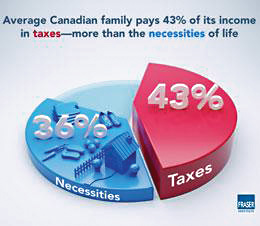Greater Toronto
Taxes - biggest expense for
Canadian families

According to Fraser Institute, the average Canadian family spent 43 percent of its income on taxes in 2017. An average family earns $85,833. Of that amount, the average family spent $37,058 in taxes. And that amount is more money than what families usually spend on housing, food, and clothing combined.
“Many Canadians will be surprised to learn that taxes – and not life’s basic necessities, including housing – is the biggest household expense,” said Charles Lammam, director of fiscal studies at the Fraser Institute. He co-authored the Canadian Consumer Tax Index, which tracks the total tax bill of the average Canadian family from 1961 to 2017.
The average Canadian family paid more than twice of their income in taxes (43.1 percent) as they did for housing (20.8 percent). Basic needs, including food, clothing, and housing, totaled 35.6 percent of income.
In 1961, the average Canadian family spent 33.5 percent on taxes and only 56.5 percent on the basics.
Since 1961, the average Canadian family’s total tax has increased 2,112 percent, compared to 1,480 percent in annual housing, 732 percent in clothing and 625 percent in food.
Last year, the average Canadian family earned $85,883 and paid $37,058 in total taxes compared to $30,597 on housing (including rent and mortgage payments), food and clothing combined.
Even after accounting for inflation, the tax bill has still increased 166.4 percent over this period.
The policy: recognizes that education is vitally important to a person’s social, academic and economic development; reflects a broad definition of disability; provides students and families with up-to-date information about their human rights and responsibilities; offers practical guidance to education providers to meet their legal duty to accommodate; reminds schools of their obligation to maintain accessible, inclusive, discrimination and harassment-free spaces.
The recommendations set out actions the government, schools and post-secondary institutions should take to make the education system inclusive, function effectively and allow students with disabilities to thrive.
“All students have the right to an education that allows them to meet their full potential and contribute to society, and yet students with disabilities continue to face obstacles accessing education services in Ontario,” said OHRC Chief Commissioner Renu Mandhane.
“Our policy and recommendations call on key players in the sector to take proactive steps to remove barriers and put an end to discrimination in education, so that all students can gain the skills and knowledge they need to succeed.”
